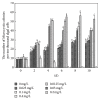Sequestration and Distribution Characteristics of Cd(II) by Microcystis aeruginosa and Its Role in Colony Formation
- PMID: 27777956
- PMCID: PMC5061931
- DOI: 10.1155/2016/9837598
Sequestration and Distribution Characteristics of Cd(II) by Microcystis aeruginosa and Its Role in Colony Formation
Abstract
To investigate the sequestration and distribution characteristics of Cd(II) by Microcystis aeruginosa and its role in Microcystis colony formation, M. aeruginosa was exposed to six different Cd(II) concentrations for 10 days. Cd(II) exposure caused hormesis in the growth of M. aeruginosa. Low concentrations of Cd(II) significantly induced formation of small Microcystis colonies (P < 0.05) and increased the intracellular polysaccharide (IPS) and bound extracellular polysaccharide (bEPS) contents of M. aeruginosa significantly (P < 0.05). There was a linear relationship between the amount of Cd(II) sequestrated by algal cells and the amount added to cultures in the rapid adsorption process that occurred during the first 5 min of exposure. After 10 d, M. aeruginosa sequestrated nearly 80% of 0.2 mg L-1 added Cd(II), while >93% of Cd(II) was sequestrated in the groups with lower added concentrations of Cd(II). More than 80% of the sequestrated Cd(II) was bioadsorbed by bEPS. The Pearson correlation coefficients of exterior and interior factors related to colony formation of M. aeruginosa revealed that Cd(II) could stimulate the production of IPS and bEPS via increasing Cd(II) bioaccumulation and bioadsorption. Increased levels of cross-linking between Cd(II) and bEPS stimulated algal cell aggregation, which eventually promoted the formation of Microcystis colonies.
Figures








Similar articles
-
Effects of lead(II) on the extracellular polysaccharide (EPS) production and colony formation of cultured Microcystis aeruginosa.Water Sci Technol. 2013;67(4):803-9. doi: 10.2166/wst.2012.632. Water Sci Technol. 2013. PMID: 23306258
-
CHANGES IN THE MORPHOLOGY AND POLYSACCHARIDE CONTENT OF MICROCYSTIS AERUGINOSA (CYANOBACTERIA) DURING FLAGELLATE GRAZING(1).J Phycol. 2008 Jun;44(3):716-20. doi: 10.1111/j.1529-8817.2008.00502.x. J Phycol. 2008. PMID: 27041430
-
High Ca2+ concentrations enhance Microcystis colony formation through upregulating polysaccharide-, energy metabolism-, and transmembrane transport-related pathways.Harmful Algae. 2025 Feb;142:102806. doi: 10.1016/j.hal.2025.102806. Epub 2025 Jan 29. Harmful Algae. 2025. PMID: 39947858
-
[Effects of abiotic factors on algal extracellular polysaccharides content].Ying Yong Sheng Tai Xue Bao. 2008 Jan;19(1):198-202. Ying Yong Sheng Tai Xue Bao. 2008. PMID: 18419095 Review. Chinese.
-
Review: a meta-analysis comparing cell-division and cell-adhesion in Microcystis colony formation.Harmful Algae. 2017 Jul;67:85-91. doi: 10.1016/j.hal.2017.06.007. Epub 2017 Jul 8. Harmful Algae. 2017. PMID: 28755723
References
-
- Zhao L. F., Lu L., Li M., Xu Z. R., Zhu W. Effects of Ca and Mg levels on colony formation and EPS content of cultured M. aeruginosa . Procedia Environmental Sciences B. 2011;10:1452–1458.
-
- Wang W., Liu Y., Yang Z. Combined effects of nitrogen content in media and Ochromonas sp. grazing on colony formation of cultured Microcystis aeruginosa . Journal of Limnology. 2010;69(2):193–198. doi: 10.3274/jl10-69-2-01. - DOI
-
- Yuan H. Z., Shen J., Liu E. F. Assessment and characterization of heavy metals and nutrients in sediments from Taihu lake. Journal of Environmental Sciences-China. 2011;32(3):649–657. - PubMed
MeSH terms
Substances
LinkOut - more resources
Full Text Sources
Other Literature Sources

